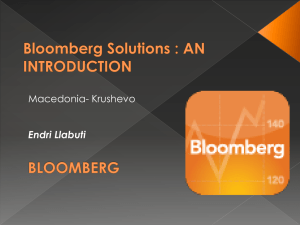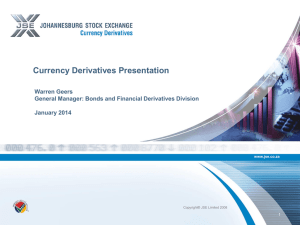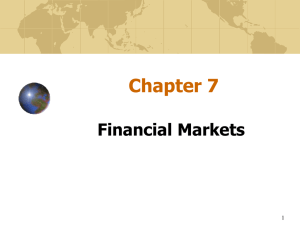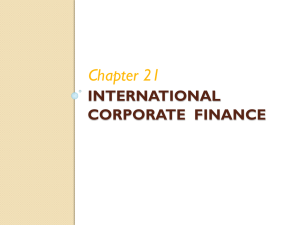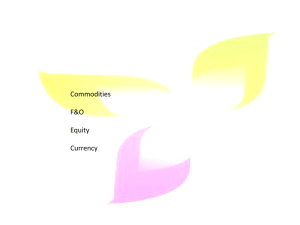derivatives trading - currency futures
advertisement
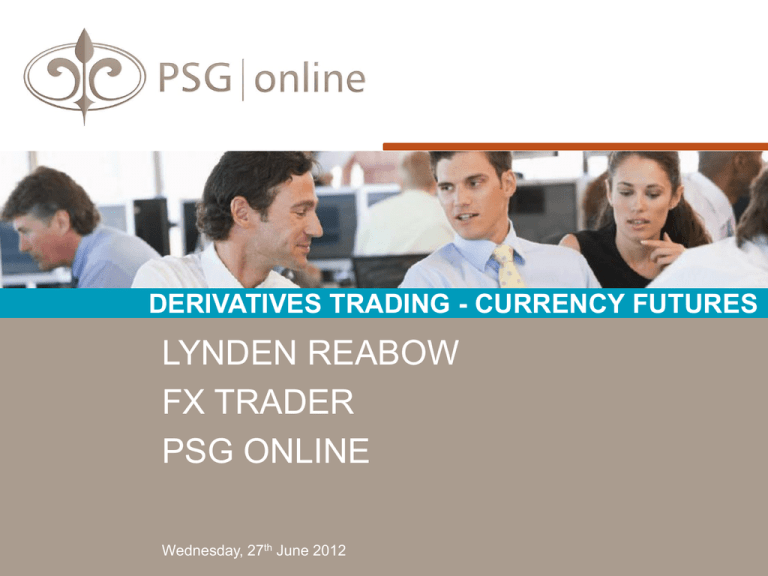
DERIVATIVES TRADING - CURRENCY FUTURES LYNDEN REABOW FX TRADER PSG ONLINE Wednesday, 27th June 2012 INTRODUCTION • The foreign exchange market operates 24 hours a day. • Markets open in the Far East, and as Tokyo winds down, European markets open followed by the US, and as the US reaches its close, the Far Eastern markets open their doors once again. • Turnover in the FX Spot market has increased from $5 Billion in 1977 to $3.2 Trillion a day! • In South Africa the currency futures market only began in 2007, total value traded in 2007 was R1.5 billion. • In 2011 R100 billion traded locally. INTRODUCTION Graph 1: Value of currency futures traded in SA 2007-2012 Currency Futures Value Traded (CUM) R 350,000,000,000 R 300,000,000,000 R 250,000,000,000 R 200,000,000,000 Value Traded R 150,000,000,000 R 100,000,000,000 R 50,000,000,000 R0 2007 2008 2009 2010 2011 2012 INTRODUCTION • The large size of the FX market is important as it contributes towards: – – – – – Continuous and full liquidity Around the clock trading Around the globe trading High efficiency Price stability • The US dollar is the most widely traded currency and accounts for 40 – 45 per cent of all spot forex trading. WHY PROFESSIONALS TRADE FOREX • The forex market has established itself as an additional asset class. • There is no correlation with other asset classes, thus you are likely to protect your portfolio through diversification. • Forex market exhibits a market that offers, size, consequent liquidity, accessibility, leverage and popularity. • The forex market is 24 times the average daily turnover of global equity markets (USD130 billion). • A new breed of “day trader” has found a fertile new playground. FOREIGN EXCHANGE ANALYSIS • The forex investment product is very simple but the factors determining the prices are highly complex. • Primary analysis techniques used by forex market traders: – Fundamental analysis 41% – Technical analysis 26% – Flow Information 16% – Quantitative analysis 17% IMPORTANCE OF ECONOMIC DATA • Fundamental analysts follow the consistent releases of macroeconomic data of the countries whose currencies they trade. • Technical analysts evaluate market prices based on historical price patterns. • Important economic data influencing the currency markets are: – – – – Employment data Consumer confidence data Manufacturing / production data Dollar Index (measures the performance of the dollar against a weighted basket of other currencies) – Vix Index (measures the implied volatility of the S&P Index) – US 10 Year Treasury (if yields decrease is shows investors buying US treasuries i.e. risk aversion, running for safety) DIFFERENT CURRENCIES • Major Currencies – – – – – USD GBP EURO JPY CHF • Minor Currencies – Singapore Dollar, New Zealand Dollar, Indian Rupee. • Exotic Currencies – Indonesian Rupiah, Thai Baht, Hong Kong Dollar, Malaysian Ringgit. • Emerging Market Currencies – South African Rand – Russian Rouble – Brazilian Real DIFFERENT CURRENCIES • Emerging markets currencies are lumped together and any occurrence affecting one emerging market currency may spread like wild fire through all emerging market currencies. • Investors in emerging market currencies must therefore always keep a tab on generic developments in other emerging markets. • South Africa is also known as one of the “commodity countries”. Developments regarding the prices of metals such as gold, platinum and silver, and occurrences like bull or bear markets in commodities generally impact on the South African rand. WHO ARE CURRENCY TRADERS • • • • • • • Investment funds Asset managers Hedge funds Multinational corporations Banks Trading advisors / money managers Individual “retail” speculators i.e. YOU! • Speculators do not consider taking or making delivery of foreign exchange. WHAT IS A CURRENCY FUTURE • Currency futures are standardised contracts that are traded on the JSE’s Currency Derivatives Trading Platform. • Traders choose to either buy (long) or sell (short) a specific currency pair. For example, if you think the US Dollar is going to strengthen relative to the South African Rand, you would go long/buy the USDZAR contract. By doing this you are automatically buying Dollars and selling the Rand at the same time. • Alternatively, you might think that the Euro is overvalued relative to the South African Rand (and therefore should weaken) in which case you would short/sell the EURZAR contract. By doing this you are automatically selling Euros and buying the Rand at the same time. CURRENCIES TRADED ON THE JSE • • • • • • • • Dollar/Rand Euro/Rand Pound/Rand Aussie Dollar/Rand Yen/Rand Canadian Dollar/Rand Swiss Franc/Rand One can also trade synthetic crosses for example, EUR/USD, GBP/USD and GBP/EUR. Synthetic trades are becoming increasingly popular amongst investors as the margin requirements are considerably less than Rand bases crosses. CURRENCY FUTURE DETAILS • Contract size – 1 contract exposes you to 1,000 of the foreign underlying currency e.g. US$1000 or €1000 or ₤1000 • Standardised contracts – Expire in March, June, September and December. • Price Movement 1 c = R10 Profit or Loss per contract • Cash Settled on expiry in Rands. • Contracts quoted in SA Rand to 4 decimal places (On the futures exchanges one unit is not called a “pip” but a “tick”). • No physical delivery of foreign currency. • Gearing/Leverage, can be as high as 20 times, we limit it to 10 times. • Contract can be closed or rolled at the end of the contract expiry to the next contract period. JSE ADAPTNG TO NEW DEMANDS • In a effort to increase liquidity and boost the currency future market in SA, as of 11th June 2012, the JSE has introduced a system where by all day trades and synthetic trades will only pay JSE clearing and settlement fees on one leg of the trade. • Trading costs are halved on day trades. • PSG has also dropped the min brokerage fee of R100, it thus possible to now trade 1 contract and only pay R18 brokerage. HOW CURRENCY FUTURES WORK • In order to open the futures position an investor must deposit the necessary initial margin with the JSE. – Initial margin is 2 times the JSE margin. 50% of this amount will go to initial margin and the other 50% will go to retained margin, used as a buffer for MTM movements. – Marked-to-Market (MTM) – The daily revaluation of each open position by the exchange at the close of each business day. – Variation margin – the daily process through which the unrealised profits and losses are processed into the client’s cash account by the exchange through the MTM process. • Leverage (or “gearing”) simply means to trade with margin. The value of currencies transactions engaged is higher than the amount a trader or investor has on margin. • Leverage is a double-edged sword. Leveraged positions can lead to large gains if the exchange rate between two currencies moves as anticipated, but conversely will cause large losses if the exchange rate moves in the opposite direction. The concept of being “wiped out” is not just a theoretical possibility, but a real one. WHERE TRADING OCCURS • The spot currency market is “over-the-counter” which means it is “decentralised” consisting of a multiplicity of closely cooperating “markets”. – Spot currency prices, at any given moment, vary from dealer to dealer or bank to bank or dealing desk to dealing desk or market maker to market maker. There is not one global “price” for any currency pair at any given moment in time. • Currency futures on the other hand trade on “organized exchanges” i.e. the JSE's Currency Derivatives Trading Platform. • On the exchanges, trading takes place publicly in a centralised location. – Hours, trading practices and other matters are regulated by the JSE. – Margin payments, daily marking to market, and cash settlements through a central clearing house and guaranteed by the JSE. SPOT PRICE VS. FUTURE PRICE • The difference between the spot price and the futures prices is as a result of “The forward points”. • The forward points are a function of the interest rate differential between the two domestic countries. • The forward points should offset, or neutralise the interest rate differential between the two currencies and prevent any risk-free arbitrage opportunities. CALCULATING THE FUTURE PRICE • To calculate the forward points, the following elements play a role: – The deal date – The maturity (or settlement) date – The overnight interest rates of the applicable countries (currencies) CALCULATING THE FUTURE PRICE • For example: – Maturity date is 82 days forward (27 June 2012 to 17 Sep 2012). – The spot exchange rate USDZAR: 8.20 – South African JIBAR = 5.595% (0.5595) – US 3 month Treasury = 0.1% (0.0100) • • Points are added when the interest rate of the base currency (USD) is the lower one (0.1% vs. 5.595%), since the base currency should trade at a forward premium. The future rate would thus be 8.20000 + 0.1234 = 8.3234 SPECULATIVE TRADING • Normal future trade – Dollar Bear – Sizwe feels that in the current economic environment there is a lot of positive sentiment and he feels that we will start seeing a more risk on* environment coming our way and consequently feels that the dollar is overvalued and should depreciate in the near future. – On day 1 the spot rate is trading at 8.2000 and the future is at 8.3234 . Sizwe sells 100 Sep 12 USDZAR contracts @ 8.3234 Margin per contract is R340.00 per contract. (Remember margin must be multiplied by 2). Brokerage is R18.00 per contract (Brokerage is paid to open the position and again when the position is closed). – Client pays to PSG R69 800 (R68 000 +R 1 800) Initial margin earns interest on deposit at SAFEX rates. *A risk on environment causes investors to shy away from safe haven assets like the USD, JPY and CHF. Money flow should then favour risky assets. The Rand is a regarded as a risk asset being an emerging market currency. SPECULATIVE TRADING • On day 4 the spot rate is trading at 8.00 and the future is at 8.1234 • Sizwe buys the 100 Sep USDZAR contracts back at 8.1234 - Gross Profit = R20,000 - Total Brokerage = R3,600 (R1,800 X 2) - Net Profit = R16,400 • The initial capital outlay of R68,000 has returned a profit of R20,000. A return of 30% during the period in which the Rand only weakened by 2.4% If this was day trade (i.e. opened and closed on the same day) brokerage would only have been paid on the one leg. Total brokerage would then been R 1,800 SPECULATIVE TRADING Cash Flow Table Day 1 Trade Date Day 2 Day 3 Day 4 Initial Margin R -68 000 R 0.00 R 0.00 R 68 000 Brokerage R -1 800 Trade Price R 8.3234 R 8.2500 R 8.1500 R 8.2300 MTM Price R 8.2500 R 8.1500 R 8.2300 R8.1234 (CLOSED AT) Profit/(Loss) for the day 8.3234-8.2500 8.2500-8.1500 8.1500-8.2300 8.2300-8.1234 x R10.00/pip 0.7340 1.0000 -0.8000 1.0700 x100 73.40 100.00 -80.00 106.60 x number of contracts (100) R 7 340 R 10 000 R -8 000 R 10 660 Net Cash flow for the day R 5 540 R 10 000 R -8 000 R 8 860 R -1 800 SPECULATIVE TRADING - SYNTHETIC • • Rationale: The markets continue to show much risk. The U.S. isn't great but doing OK, the back drop in the Eurozone is still in a mess. Greece’s economic future and future in the eurozone remains uncertain. Investors still favour running to the safety of the U.S. dollar on mounting concerns of the instability in the Spanish and broader European banking sector, amid a lack of immediate policy responses from European leaders. The markets have been downgrading their views on China, as its economy slows and get sets for a soft landing. To arrest market fears, proactive measures are needed, and investors need to be convinced that austerity measures will be implemented and adhered to, unfortunately, they seem nowhere in sight. This suggests that risky assets are likely to trade erratically at best, with a bias. In South Africa we cannot trade foreign crosses directly. We have to trade two crosses vs. the Rand which collapse to form a synthetic trade. Advantage - Exposure to foreign crosses - Margins net off - Investor get great exposure for less margin • • • • • • • One day1 the spot EURUSD is trade at 1.3302 Spot EURZAR is trading at 10.0315 and the future is trading at 10.0774 Spot USDZAR is trading at 7.5425 and the future is trading at 7.5540 Thus the spot synthetic is equivalent to = 1.3300 And the future synthetic is equivalent to = 1.3340 Investor A sells 100 Sep 12 EURZAR contracts @ 10.0774 Investor A buys 100 Sep 12 USDZAR contracts @ 7.5400 SPECULATIVE TRADING - SYNTHETIC • These two trades collapse to form the synthetic short euro/long dollar at a synthetic futures rate of 1.3340 and a implied synthetic spot of 1.3300 • • • • • Margin on the individual positions Sells 100 Sep 12 EURZAR contracts = R 40 000 Buys 100 Sep 12 USDZAR contracts = R 37 500 However as this is a synthetic trade, the JSE will net off margin. Net margin on the synthetic is now only R 10 500 • • • Brokerage is R18.00 per contract (Brokerage is only paid on the one leg as this is a synthetic trade) Client pays to PSG R12 300 (R10 500 +R 1 800) Initial margin earns interest on deposit at SAFEX rates • • • • • • • 6 months later the spot EURUSD is trading at 1.2501 Spot EURZAR is trading at 10.5908 and the future is trading at 10.6270 Spot USDZAR is trading at 8.4726 and the future is trading at 8.4937 Thus the spot synthetic is equivalent to = 1.2500 And the future synthetic is equivalent to = 1.2512 • Gross Profit = R 37 080 Total Brokerage = R3 600.00 (R 1 800 X 2) Net Profit = R 33 480 The initial capital outlay of R10 500 has returned a profit of R 37 080 A return of 353% during the period in which the EURUSD only weakened by 6% SPECULATIVE TRADING - SYNTHETIC PNL TABLE SELL EURZAR Direction Contracts Spot Price Fut Price Exposure ZAR Value Total Bro (ZAR) Open Position Close Position Sell Buy 100 100 R 10.03 R 10.59 R 10.08 R 100 000 R 1 003 150 R 10.63 R 100 000 R 1 059 080 R 1 800 R0 End Value R -1 059 080 Initial Value R 1 003 150 Less Brokerage R -1 800 Profit (ZAR) R -57 730 End Value R 847 260 Initial Value R -754 250 Less Brokerage R -1 800 Profit (ZAR) R 91 210 Net PNL R 33 480 BUY USDZAR Direction Contracts Spot Price Fut Price Exposure ZAR Value Total Bro (ZAR) Open Position Close Position Buy Sell 100 100 R 7.54 R 8.47 R 7.55 R 8.49 R 100 000 R 754 250 R 100 000 R 847 260 R 1 800 R0 HEDGE TRADING – EXAMPLE 1 • • • • • • • Client A would like to send money abroad as part of his 4 million Rand off shore allowance. He has decided to use half and send 2 million Rand abroad. With this money he intends to invest in equities and property abroad . Client A has taken a look at the current spot price of 8.2000 and feels that this is an ok level and he wishes to do the spot conversion. He is concerned that the Rand will weaken from its current levels, and he will get less foreign currency for his Rand as a result by the time he does the actual conversion in a month’s time. Solution: Hedge the currency with the use of a future and lock in a rate. How does it work? Buy the USDZAR future contract, this will give him the right to buy USD/sell Rand at a specified rate and a specified date. One day 1 Client A buys 244 Sep 12 USDZAR at 8.3224 In 1 month when the client does the spot conversion to convert Rands into Dollars at his local bank to send abroad, the Rand as expected, has weakened. He has lost R0.30c by the Rand moving from 8.2000 to 8.5000. However on his future hedge he has made R0.30c USDZAR contract was bought at 8.3224 on the future and the future is now currently trading at 8.6224 This has translated into a net profit on the hedge of R 65 001 which has offset the loss on the spot transaction effectively locking in the original spot rate of 8.2000 HEDGE TRADING – EXAMPLE 1 Cash Flow Table Day 1 Trade Date Day 2 Day 3 Day 4 Initial Margin R -165 920 R 0.00 R 0.00 R 165 920 Brokerage R -4 392 Trade Price R 8.3200 R 8.4300 R 8.5700 R 8.4700 MTM Price R 8.4300 R 8.5700 R 8.4700 R8.6224 (CLOSED AT) Profit/(Loss) for the day 8.3200-8.4300 8.4300-8.5700 8.5700-8.4700 8.4700-8.6224 x R10.00/pip x100 1.1000 110.00 1.4000 140.00 -1.0000 -100.00 1.5200 152.40 x number of contracts (244) R 26 840 R 34 160 R -24 400 R 37 185.60 Net Cash flow for the day R 22 448 R 34 160 R -24 400 R 32 793.60 R -4 392 HEDGE TRADING – EXAMPLE 2 • • Rationale AngloGold’s income is derived from the performance of Dollar denominated gold prices. The primary driver of gold prices is Dollar strength / weakness. A negative correlation exists between the share price of AngloGold and the Dollar. As the Dollar strengthens Anglo’s share price decreases. The risks therefore to the holders of Anglo shares are fluctuations in the USDZAR. The solution then is to hedge out the investor’s foreign currency exposure. If this is done, the investor then has the exposure to the performance of Anglo as a company without the currency risk. Futures 1,000 ANG shares @ R306 = R306, 000 exposure / 8.3846 USDZAR = $36 495 exposure = long 36 USDZAR future contracts RISKS OF TRADING CURRENCIES • Currency futures are geared instruments. – With this leverage/gearing you are able to make large profits from small initial layouts of capital. However the opposite is also true. Should the trade move against you, you could incur large losses as a result of the leverage/gearing. • There is a risk that you may lose more money than you initially invested. • The most important thing to remember is that not every trade will be a successful trade resulting in profits. • With every trade you should also have a target price/profit target in mind. Be strict and diligent. Don’t trade on emotion; trade on fundamentals, a strategy and logic with some common sense. • It is very tempting to ride a trade into profit and stay in the trade looking for larger gains. This can go wrong and you may well ride the trade all the way back into losses. ADVANTAGES • A known currency rate can be traded and locked in. • There is no need to hold the futures contract till expiry, the contract can be closed or traded out at anytime. • Due to the fact that the contracts trade on the JSE, investors enjoy a liquid market with dedicated market makers making competitive prices with tight spreads. • Futures are geared products, which mean currency traders do not have to deposit cash to cover the full value of the position. • Importers and exporters can dynamically hedge their currency risk far more efficiently using futures due to the ease of entering and exiting futures positions and the low cost per trade. • The daily mark-to-market process allows clients the ability to track their profit or loss situation and to adjust their portfolio accordingly. • Once the position has been closed out, all settlement occurs in Rand. ADVANTAGES OF PSG • • • • • • PSG is a well-known, independent and respected financial services provider in South Africa. PSG is regulated by the financial services board of South Africa as well as being a member of the Johannesburg Stock Exchange. PSG traders are highly skilled and are approved by the JSE to trade on the South African Futures exchange. PSG is able offer a competitive trading brokerage of R18 per contract, which includes the JSE clearing and settlement fee. The spreads / prices that you receive are the same as those that are trading on the JSE. PSG does not add to or adjust the contract spreads / prices. There is no monthly account fee. You will receive daily market research, market commentary, trader’s views, trading ranges and trade ideas to help you make informed and educated investment decisions. Clearly that is wealth simplified, but if all of that doesn’t convince you, then we should tell you that there is one thing we wouldn’t trade… The fact that we were voted stockbroker of the year 2011** **As voted for by Business Day Investors Monthly. HOW DO I START • Visit the Currency Futures page on the PSG Online website – click here • Call PSG Online on 0860 PSG PSG / 774 774 or email info@psgonline.co.za • Our Currency Futures team will arrange for the opening of your account. • You can register online – click here Contact us Thank you Lynden Reabow: Sales Trader lynden.reabow@psgonline.co.za 021 799 8136 078 756 28 27 Ockert van Niekerk: Head of Trading Ockert.vanniekerk@psgonline.co.za 021 799 8111 Heidi van Niekerk: Compliance Officer Heidi.vanniekerk@psgonline.co.za 021 799 8087
